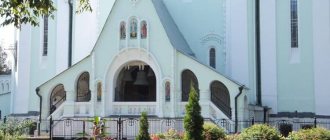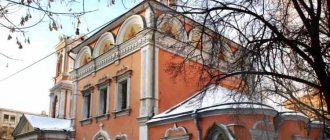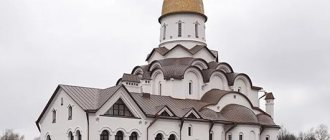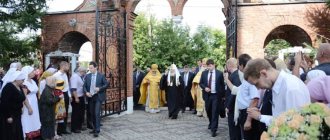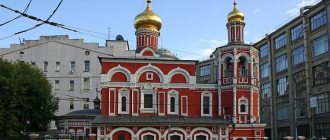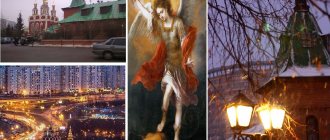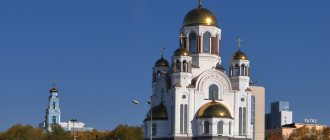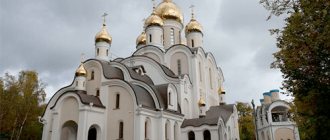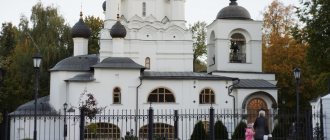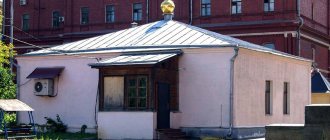The centuries-old (starting from the 17th century) history of the temple is fascinating, mysterious and, of course, providential. The main Christian Shrine, the main Christian temple is the Church of the Resurrection of Our Lord Jesus Christ in Jerusalem.
Resurrection of the Word” is such a mysterious name that not everyone understands. Until 326, a pagan temple of Venus stood on this holy place, so the consecration of the new temple was a revival, a “renewal” of the desecrated shrine.
The temple is located in the quarter where the creative intelligentsia of the capital has always lived: the House of Composers and the House of Artists are nearby, and the Conservatory is within walking distance. On every Sunday and holiday, the Church of the Resurrection of the Word was filled with worshipers, and on Easter night all the streets adjacent to it were filled with people standing with lit candles.
Shrines of the Wonderworker SPIRIDON TRIMIFUNTSKY in Moscow.
For four decades, Metropolitan Pitirim of Volokolamsk and Yuryev served in the Church of the Resurrection of the Word. The Church of the Resurrection of the Word has preserved within its walls many shrines from surrounding churches that were closed during Soviet times.
Before the image of our Most Holy Lady Theotokos “Seeking the Lost” every Sunday at 18:00 in our church at the end of Vespers a prayer service with an akathist is served, but see the schedule of services.
Saint Spyridon is depicted on an icon richly decorated with a robe, in the center of which there is an opening ark containing part of the holy relics of the Saint.
During his lifetime, the saint healed many sick people, so they also pray to him for healing in illness. Akathist to Saint Spyridon, Bishop of Trimifuntsky in our church is performed on Tuesdays after Vespers at 18:00, but see the schedule of services. From the name of the temple, this place in Moscow (or, as they used to say in the old days, “tract”) received the name “Uspensky Enemy” (ravine).
Therefore, temples outside Jerusalem were often built not in the name of the Resurrection itself, but precisely in honor of the holiday, which is “reputed” for the Resurrection. The icon “Recovery of the Lost” arrived in the temple no earlier than 1937. From the first years of the 19th century until the mid-1930s, it was located in the Church of the Nativity of Christ in Palashi.
History of the temple
The first mention of the temple on the Assumption Vrazhek dates back to 1548; on Peter’s plan of Moscow the building was designated in 1596-1598. At that time, a wooden church stood on this site, built in honor of the holiday of the same name.
In 1629, due to a major fire, the wooden building was completely burned down. Local residents immediately began construction of a stone cathedral. Due to an incorrect reading of the chronicle, for a long time April 10, 1629 was considered the date of the start of construction. The book itself indicates the date of the fire, after which construction began in a short time (most likely in the summer of the same year). It was completed in 1634: on July 4, the priest asked in a letter for the blessing of 2 thrones.
At the beginning of the 19th century, the bell tower and refectory were rebuilt; in the second half of the century, the window openings were expanded and framed in the Russian style. At the end of the century, the upper tiers of the bell tower were replaced: the new ones were made in a pseudo-classical style according to Meissner's design. The reason for the restructuring was the donation of a bell that was too large. The temple has survived in this form to this day.
It is noteworthy that in the Soviet Union the cathedral was not demolished or even closed - they were only deprived of the bells. This became possible thanks to the intercession of famous artists who lived on Nezhdanova Street. They were also his parishioners: they note that singers brothers Pirogov and Kozlovsky, actors Smoktunovsky, Zamansky and Stanislavsky, opera artists Migaya and Nezhdonova, soloist of the Bolshoi Theater Maksakova and many others came to the services. Icons and shrines from closing churches were transferred to the temple for safekeeping.
Restoration work was even carried out - in 1963-1964, 1979 and 1982-1986. The last restoration was completed only in 2022: 40 paintings on the vaults and walls, 2 medallions above the windows were restored. Today the temple is an architectural monument and is protected at the state level.
The temple is made in a manner typical for a small townsman temple of the 17th century. Its building was a pillarless, single-domed quadrangle. There were few decorative elements: modest window frames, corner pilasters, a patterned “belt”.
Little has survived from the first version: a 3-part apse and a two-height quadrangle. The refectory and bell tower were built only at the beginning of the 19th century; during subsequent restoration work, the southern wall was opened and elements were added. Modern wall paintings and stuccoes most likely date back to the end of the 19th century.
The outside walls are also decorated with images of saints. Many people regularly receive flowers and candles.
Chapels and shrines
In total, there are 3 limits in the temple: the Resurrection of the Word (main), St. Nicholas the Wonderworker (northern), the Prophet of the Yenisei (southern). The latter was moved here from a church that closed nearby several centuries ago.
The shrines of the temple include:
- Icon of the Mother of God “Seeking the Lost.” Moved in 1937 from the Church of the Nativity of Christ on Palashi. It is believed that it was painted around the 18th century, but until the beginning of the 19th century it belonged to a Moscow family. According to legend, one of the family members gave the icon as a gift when his prayers for the well-being of his daughters were heard and fulfilled. The icon is located in the icon case to the left of the iconostasis and is one of several most famous in Moscow. Before her they pray for recovery and healing from vices (especially drunkenness), for a happy marriage and well-being in the family.
- Icon of St. Spyridon of Trimifunt with a particle of his relics. This rare Moscow shrine is located in the main aisle on the right. Saint Spyridon was considered the patron saint of the poor and disadvantaged, merchants who conduct business honestly, and the sick. It is believed that people who are left without any means and those who may lose their housing can turn to him for immediate help.
- Icon of St. Nicholas of Mozhaisk with a particle of his relics. This is the oldest image: it was painted at the end of the 16th century. Located in the left aisle.
- Icons of the Prophet Elisha and Saint Elijah the Prophet (XVII-XVIII centuries, located in the right side chapel), icon of the Holy Martyr Justin the Philosopher (XVII century, updated in the 19th century, located in the iconostasis of the left side side chapel).
Also in the cathedral there are icons of the Mother of God (“Kazan”, “Smolensk”, “Bogolyubskaya”, “Iverskaya”, “Quench My Sorrows” and others), the wonderworkers Cosmas and Damian, the Great Martyrs Nikita and St. George the Victorious, the Martyr Tryphon, and the Venerable Savva of Storozhevsky. Many images are presented with the relics of saints.
Some icons are miraculous. You can learn about the miracles they performed on the temple website.
Name of church and place
The name of the temple is translated as “Church of the Resurrection”. It is associated with the Church of the Resurrection of Christ in Jerusalem (Church of the Holy Sepulcher). On Golgotha, the site of Christ's crucifixion, sacred to Christians, a temple to the pagan goddess Venus was built. In 355, Emperor Constantine and his mother Helen built the Church of the Resurrection (Ascension) on this site - they “renewed” the holy place, revived it. On September 26, a holiday is celebrated in honor of this event. Therefore, the full name sounds like “the temple in honor of the Renewal of the Church of the Resurrection of Christ.”
Uspensky vrazhek (Uspeniev enemy) is a small (less than a kilometer) stream, the right tributary of the Neglinnaya River, which flowed in the Tverskoy district and crossed Bryusov Lane. Today the river is enclosed in an underground sewer. The word “enemy” itself means “ravine” - the stream flowed through it. For example, Sivtsevy vrazhek is a ravine in which the Sivka (Sivets) River flowed. The Assumption enemy was the oldest in the “White City” - a place fenced under Dmitry Donskoy.
Interesting fact: the name of the stream comes from the Assumption ravine, named after the local Assumption Church on Gazetny Lane.
Celebration in the Church of St. Spyridon
Father Innocent, when did the idea of bringing the relics of St. Spyridon of Trimythous to Russia from Corfu arise? Just now, at the beginning of October, the next “Russian Week” will begin, one of the organizers of which is the Danilov Monastery. When communicating with Metropolitan Nektarios, it turned out that in 1984 the Greeks were returned from the Vatican... the right hand of St. Spyridon. This, indeed, was a real miracle, since for many centuries it was unknown where it was located.
Current state[edit]
The temple is located in the quarter where the creative intelligentsia of the capital has always lived: the House of Composers and the House of Artists are nearby, and the Conservatory is within walking distance. Therefore, the parishioners of the Temple were people of art and science, writers and public figures, actors and directors. In Soviet times, in the church one could see singer Ivan Kozlovsky, actors Innokenty Smoktunovsky and Vladimir Zamansky, Russian opera singers the Pirogov brothers, theater director and actor Konstantin Stanislavsky, opera artist Sergei Migai, opera singer Antonina Nezhdanova, Bolshoi Theater soloist Maria Maksakova and many other cultural and artistic figures, largely thanks to whom the temple was not closed during the difficult Soviet times for the Church.
Currently, at the temple there are: children's and adult Sunday schools, photography courses, courses for studying the Church Slavonic language, etc.
Description[edit]
The building of the temple (a pillarless, single-domed quadrangle) is typical of a “street” church and is a typical example of a small townsman church of the 17th century. Its walls are completed with decorative semicircular zakomars with niches; modest window frames, corner pilasters with half-columns, a cornice with a strict profile, a columnar belt on a blind, windowless, drum of the chapter - all the architectural details of its decoration. Only the general proportions and the design of the window frames indicate that the temple was built by an outstanding and experienced architect.
From the original composition of the building, only a small double-height quadrangle of the temple and a three-part apse have survived, and the wide two-aisle refectory in the classicist style and the bell tower, adjacent to the west, were erected in 1816-1820. The once five-domed quadrangle of the temple retained the completion of the walls with a wide entablature with a belt of large kokoshniks and a cylindrical drum of the central chapter, decorated with arcature. The refectory with oval-shaped aisles is decorated on the side facades with rusticated risalits at the corners with pilaster porticoes, completed with pediments.
The opening of the old (white stone) wall of the temple was done by restorers on the southern wall of the temple.
The interior of the main temple (the height from the floor to the top of the vault is about 15 m) is illuminated by two tiers of windows. The walls and vaults are covered with oil painting, which was renewed several times, but basically preserves the composition, apparently dating back to the last third of the 19th century. The vault is decorated with stucco and painted ornaments in the style of 1870-1880. The existing white and gilded carved iconostases date back, as far as one can judge from their style, to the very end of the 19th century.
Archimandrite Nektariy: I want to show children from Russia and Ukraine the best that Greece has
And everyone knew: when there are problems with housing, you always need to order prayers to St. Spyridon of Trimythous. This tradition has existed since ancient times among both ordinary and noble people. The royal family especially revered Saint Spyridon. Emperor Alexander I was born on the saint's memorial day - December 12. When he was born, the Finnish Regiment made him a fold for his baptism day, in which there were images of the Savior Not Made by Hands, St. Spyridon and Metropolitan Alexy of Moscow.
How is the meeting between people and the saint going now in the Danilov Monastery? Last time I felt so sorry for the people who stood in line for six, eight and even ten hours, and then, having venerated the shrine, immediately left the monastery.
Many people of art and science, writers and public figures, actors and directors came to this church specifically to listen to the sermons and conversations of Metropolitan Pitirim. The Resurrection of the Word is a symbol of the renewal of a person’s spiritual life, marking the resurrection.
Work with people
The Church of the Resurrection of the Word in Moscow is famous not only for its miraculous images and unusual history. Despite the modest size of the building, active public work is carried out here, the main task of which is to focus on the spiritual development of a person.
Today the church operates:
- Sunday school for children and adults. Festivals and holidays dedicated to religious events are held, trips and meetings in Moscow are organized. It is open on Saturday from 14:30 to 17:00.
- Parish meetings. Those interested can attend concerts and film screenings, listen to lectures by invited guests.
- Pilgrimage trips. Visits to Moscow churches and museums are organized, as well as visits to shrines in other cities.
Also at the temple there are courses on studying the Church Slavonic language, photography, a choir and others are organized. You can find out more details and sign up for the group in person when visiting the temple.
Church of the Resurrection of the Word on Bryusov Lane - how to get there?
Getting to the center of Moscow, where the temple is located, is not too difficult from anywhere in the city. To do this, take the metro to Okhotny Ryad or Revolution Square, located not far from Manezhnaya Square. And then you need to go up Tverskaya, on its left side, to Bryusov Lane. The temple is clearly visible from Tverskaya. It’s just as easy to get to it from the opposite side, from Bolshaya Nikitskaya Street. From here you can get to Bryusov Lane by turning right. The address of the temple is Moscow, Bryusov Lane - 15/2.
How to get there[edit]
Address:
Bryusov lane, 15/2, Moscow, 125009
Directions:
metro station “Okhotny Ryad”, “Pushkinskaya”, “Tverskaya”, then walk
For questions related to the schedule of services and general questions, please contact :
+7 (495) 629-6616
For questions of faith and preparation for the sacraments (baptism, wedding, etc.), parish consultant Sergei Ivanovich daily from 12 to 18 o’clock in the church or by phone:
+7(916) 325-3644
For questions regarding the provision of material assistance, as well as those wishing to donate items for those in need, call the Social Service:
+7 (909) 922-2096 (number also available in Viber and WhatsApp)
Phone number of the priest on duty:
+7 (915) 218-7199
Email:
Schedule of services
At the end of the article, we will touch on another important issue. As already mentioned, the Church of the Resurrection of the Word attracts many pilgrims, sometimes coming from distant corners of Russia, and wanting to visit this ancient temple in Bryusov Lane. The schedule of services below will help them navigate his busy religious life.
So, on weekdays, hours and confession begin at 8:40, and liturgy at 9:00. Evening services are held at 18:00. As for Sundays and holidays, their schedule is busier and more intense. The doors of the church open at 6:30 for everyone who wants to stand the watch and confess, and at 7:00 the early liturgy is celebrated, followed by the late liturgy at 10:00. At 18:00, evening services begin, including, in addition to Vespers, the reading of akathists provided for that day by the church calendar.
Architectural features of the temple
The building of the Church of the Resurrection of the Word on Uspensky Vrazhek, the design of which is based on a pillarless single-domed quadrangle, is a building very typical of church architecture of the 17th century. A characteristic feature of its walls are the zakomaras - the semicircular decorative endings crowning them. The general style of the era is complemented by vertical projections of the walls - corner pilasters decorated with half-columns.
The fact that the building was erected by an experienced and extraordinary master (whose name remains unknown) is evidenced by many details of the architectural decoration. One involuntarily attracts the eye to the modest, but at the same time, very skillfully executed window frames, the cornice running along the profile of the building, the dome drum and many other design elements of the temple in Bryusov Lane.
Temple name
The unusual name of the temple on Bryusov Lane is associated with the events of sacred history. The Church of the Resurrection of Christ was opened in 335, on the site of the Holy Sepulcher in Jerusalem. It is in the very place where Christ was buried and resurrected. And only the Jerusalem Temple has the right to such a name. Therefore, churches dedicated to this event in other countries are named in honor of the “Resurrection of the Word.” They are dedicated not to the most central event of sacred history, but only to the holiday in honor of it.
Bell tower
The repressions of the Soviet period still did not spare this ancient Moscow church. But they only expressed themselves in the fact that unique historical bells were removed and destroyed from its bell tower. For several decades, the bell tower of the temple served an exclusively decorative function. The residents of Bryusov Lane were destined to hear the bell ringing again only on February 18, 2008, on this day the main bell of the Church of the Resurrection “Archangel Michael” was consecrated again. Now in this ancient corner of Moscow you can hear the ringing of bells on all canonical Orthodox holidays.
During Soviet times
For many, it remains a mystery why, during the years of severe persecution of Orthodoxy and state atheistic propaganda in the capital of communist Russia, and then the Soviet Union, the Church of the Resurrection of the Word in Bryusov Lane did not stop serving for a single day? We should not forget that many Orthodox churches in Moscow in the thirties of the twentieth century were barbarously blown up and destroyed. But the Temple of the Resurrection was always open to believers. Some explain this fact by the unusual status of the area in which Bryusov Lane is located. It has long been home to Moscow's creative bohemia - literary and artistic figures, musicians, actors, artists. It was their participation that helped prevent the demolition of the ancient church. In particular, this merit is attributed to the great Russian director and actor K. S. Stanislavsky, whose opinion was listened to by the most influential persons of the Soviet state. But Orthodox believers see God’s special providence in the preservation of their beloved temple.
